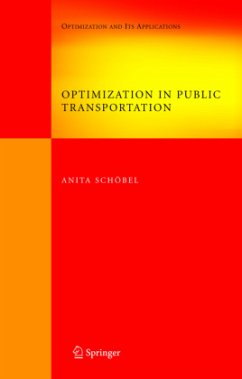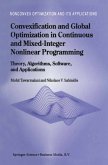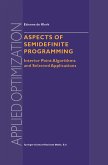Customer-Oriented Optimization in Public Transportation develops models, results and algorithms for optimizing public transportation from a customer-oriented point of view. The methods used are based on graph-theoretic approaches and integer programming. The specific topics are all motivated by real-world examples which occurred in practical projects. An appendix summarizes some of the basics of optimization needed to interpret the material in the book.
In detail, the topics the book covers in its three parts are as follows:
1. Stop location. Does it make sense to open new stations along existing bus or railway lines? If yes, in which locations? The problem is modeled as a continuous covering problem. To solve it the author develops a finite dominating set and shows that efficient methods are possible if the special structure of the covering matrix is used.
2. Delay management. Should a train wait for delayed feeder trains or should it depart in time? Theauthor builds up two different integer programming models and a model based on project planning methods. Properties and solution methods are developed.
3. Tariff planning. Part 3 deals with the design of zone tariff systems, in which the fare is determined by the number of zones used by the passengers. The author presents a model for this problem and approaches based on clustering theory.
In detail, the topics the book covers in its three parts are as follows:
1. Stop location. Does it make sense to open new stations along existing bus or railway lines? If yes, in which locations? The problem is modeled as a continuous covering problem. To solve it the author develops a finite dominating set and shows that efficient methods are possible if the special structure of the covering matrix is used.
2. Delay management. Should a train wait for delayed feeder trains or should it depart in time? Theauthor builds up two different integer programming models and a model based on project planning methods. Properties and solution methods are developed.
3. Tariff planning. Part 3 deals with the design of zone tariff systems, in which the fare is determined by the number of zones used by the passengers. The author presents a model for this problem and approaches based on clustering theory.
From the reviews:
"The author ... has written a fine book that addresses three major issues in public transportation network design and operation: (1) location of stops, (2) delay management, and (3) design of tariff zones. ... it should be very useful to the OR consultants who work for PTS managers; it contains a wealth of models and algorithms. ... The book's organization is excellent. ... Each section ends with remarks on extensions of the work described in that section." (Jamshed A. Modi, Interfaces, Vol. 38 (1), 2008)
"The author ... has written a fine book that addresses three major issues in public transportation network design and operation: (1) location of stops, (2) delay management, and (3) design of tariff zones. ... it should be very useful to the OR consultants who work for PTS managers; it contains a wealth of models and algorithms. ... The book's organization is excellent. ... Each section ends with remarks on extensions of the work described in that section." (Jamshed A. Modi, Interfaces, Vol. 38 (1), 2008)
Aus den Rezensionen: "... Das vorliegende englischsprachige Werk stellt Modelle, Lösungen und Algorithmen vor, um die Abläufe im öffentlichen Personenverkehr aus kundensicht zu optimieren. ... Die speziellen Themen wurden alle durch reale Beispiele motiviert, die in realen Projekten auftauchten. Ein Anhang fasst einige der wichtigsten Grundlagen der Optimierung zusammen, die benötigt werden, um den Inhalt des Buchs zu verstehen. Das Buch richtet sich vornehmlich an Studenten und Forscher, die an einer praktischen Einführung in die Themengebiete Ganzzahlige Optimierung und Algorithmen interessiert sind." (in: mylogistics, 25. Jan. 2007)








